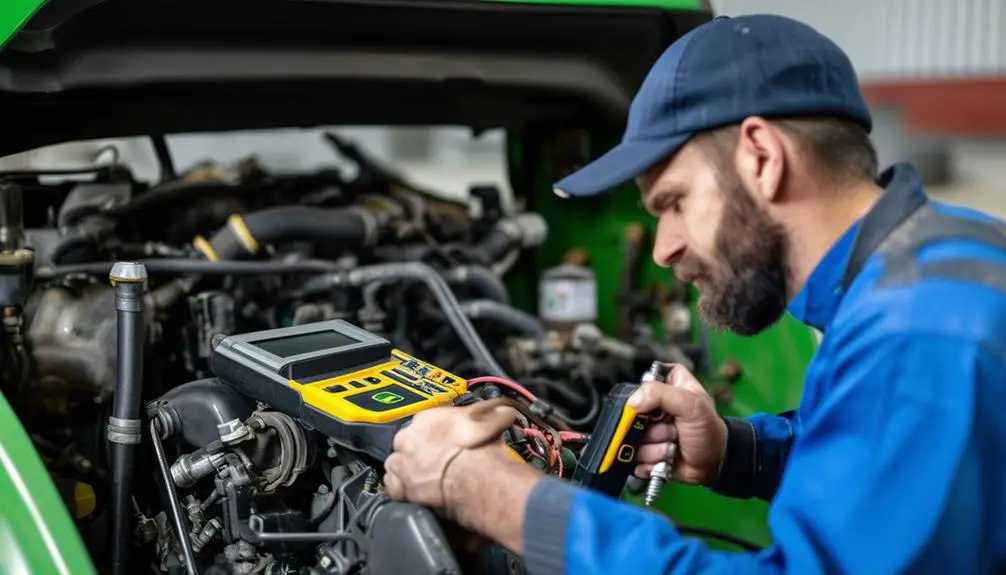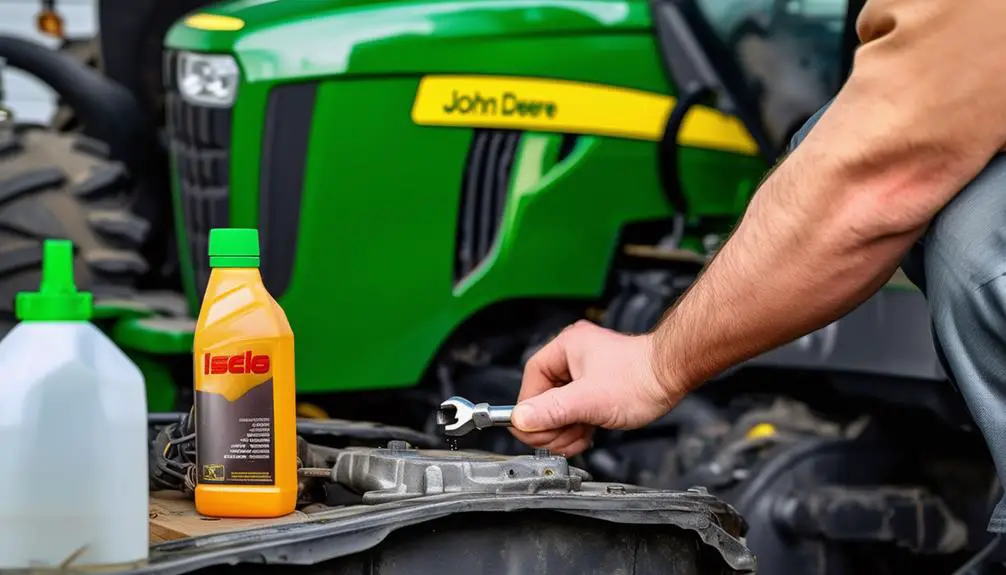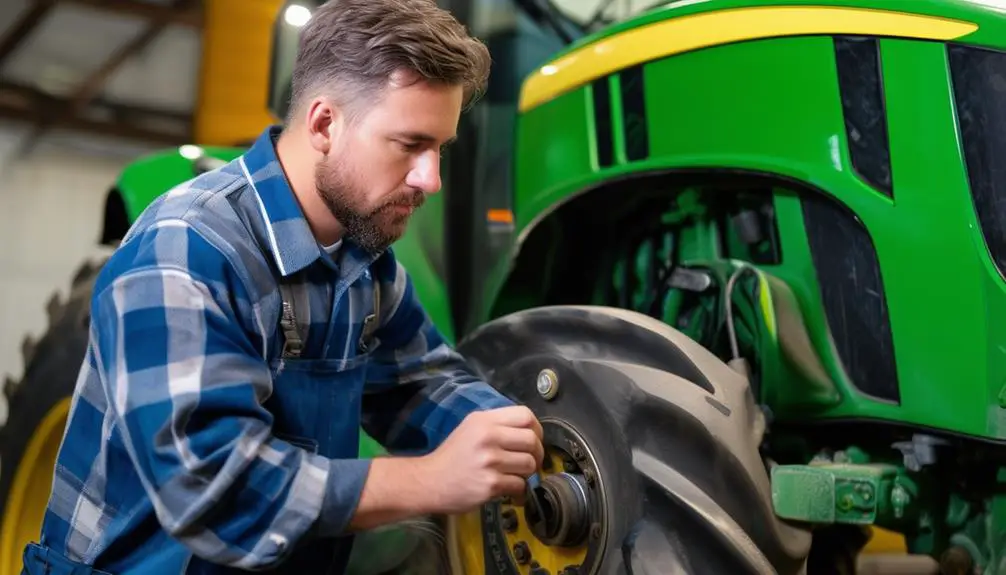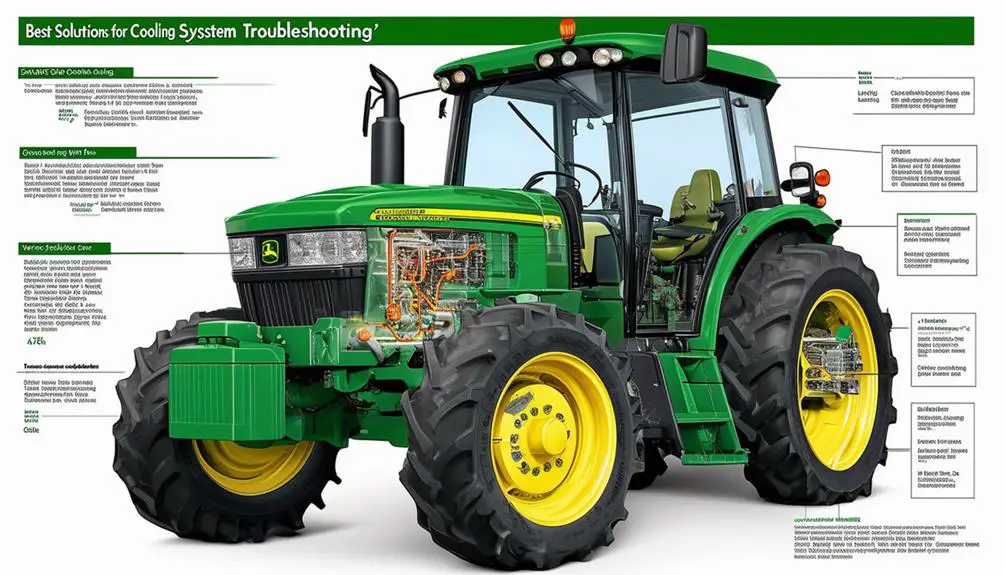When maneuvering through the maze of John Deere 2305 issues, envision these 7 solutions as guiding lights illuminating the path to smoother operations. Decipher the mysteries behind fuel filter blockages and tackle electrical glitches head-on. Delve into the depths of transmission woes and unearth the secrets to hydraulic harmony. Steer clear of steering snags and reveal the enigma of PTO malfunctions. Stay cool under pressure by mastering the art of cooling system care. Each solution holds the key to revealing a world of optimized performance for your John Deere 2305.
Things to Note
- Check fuel filter for clogs or debris to ensure proper fuel flow.
- Address slipping gears by maintaining correct transmission fluid levels.
- Inspect steering components for wear, leaks, or loose connections.
- Verify proper engagement and maintenance of the PTO system.
- Monitor hydraulic fluid levels and replace filters regularly.
Engine Troubleshooting

If your John Deere 2305 is facing engine issues, start by checking the fuel filter for clogs or blockages. A clogged fuel filter can limit the flow of fuel to the engine, causing performance issues. Freeing your tractor from this problem is straightforward: locate the fuel filter, remove it, and inspect it for any debris. If you find any blockages, clean or replace the filter to ensure proper fuel flow.
Another common engine problem in the John Deere 2305 is dirty air filters. Over time, air filters can become clogged with dust and debris, hindering airflow to the engine. To free your tractor from this restriction, locate the air filter, remove it, and either clean or replace it depending on the level of dirt accumulation. This simple maintenance task can greatly improve engine performance and efficiency.
Electrical System Fixes
When troubleshooting the electrical system of your John Deere 2305, begin by checking the battery for any signs of damage or corrosion.
Confirm the wiring harness is securely connected and inspect it for any frayed wires that may be causing electrical issues.
These simple steps can often resolve common electrical problems with your John Deere 2305.
Battery Troubleshooting Tips
Check the battery connections for any corrosion or loose fittings to troubleshoot common electrical issues in your John Deere 2305. Ensuring a secure and clean connection can significantly enhance the performance of your tractor. Here are some battery troubleshooting tips to keep your John Deere 2305 running smoothly:
| Issue | Possible Cause | Solution |
|---|---|---|
| Tractor not starting | Corroded battery terminals | Clean terminals with a wire brush and baking soda |
| Dim lights or weak electrical system | Loose battery connections | Tighten all connections securely |
| Battery draining quickly | Faulty battery or parasitic draw | Test battery health and check for any drains |
Wiring Harness Inspection
Inspect your John Deere 2305's wiring harness to guarantee the electrical system functions properly. A thorough examination of the wiring harness is important in ensuring that all electrical components are connected securely and free of damage. Begin by visually inspecting the harness for any signs of wear, fraying, or exposed wires. Pay close attention to areas where the harness may come into contact with sharp edges or moving parts that could cause abrasions.
Next, test the continuity of the wiring harness using a multimeter to check for any breaks or interruptions in the electrical connections. Make sure to test each wire individually to pinpoint any potential issues accurately.
Additionally, inspect the connectors for corrosion or loose connections that could disrupt the flow of electricity.
Regularly inspecting and maintaining your John Deere 2305's wiring harness is essential for preventing electrical malfunctions and ensuring best performance. By taking the time to inspect the wiring harness thoroughly, you can identify and address any issues before they escalate, keeping your electrical system in top condition.
Transmission Issues Solutions

Addressing transmission issues on your John Deere 2305 requires a systematic approach to pinpoint and resolve the root causes efficiently. When dealing with transmission problems, it's essential to diagnose the issue correctly before taking any action. Here are some common transmission issues and their solutions:
| Transmission Issue | Possible Cause | Solution |
|---|---|---|
| Slipping gears | Low transmission fluid | Check and refill transmission fluid levels |
| Transmission noise | Worn-out clutch | Replace clutch components if necessary |
| Difficulty shifting gears | Misadjusted shift linkage | Adjust the shift linkage for smoother gear changes |
| Transmission overheating | Clogged transmission filter | Replace the transmission filter to improve cooling |
| Leaking transmission fluid | Damaged seals or gaskets | Inspect and replace damaged seals or gaskets |
Hydraulic System Maintenance
Monitor your hydraulic fluid level regularly to maximize performance of your John Deere 2305. Remember to replace the filters as recommended to prevent contamination and maintain smooth operation of the hydraulic system.
Proper maintenance of these components will help extend the life of your equipment and prevent potential issues down the line.
Fluid Level Check
To maximize performance of your John Deere 2305, regularly monitor the fluid levels in the hydraulic system. Proper fluid levels are necessary for the smooth operation of your equipment.
Start by locating the hydraulic fluid reservoir, usually situated near the engine. Check the fluid level by looking at the sight gauge or using a dipstick, ensuring it falls within the recommended range. If the level is low, add the appropriate hydraulic fluid suggested by John Deere to prevent damage and maintain peak performance.
Regularly checking the hydraulic fluid level not only guarantees the system operates efficiently but also helps detect any potential leaks or issues early on. Maintaining the correct fluid level is vital for preventing overheating and excessive wear on the hydraulic components.
Filter Replacement
Maximize performance of your John Deere 2305 by regularly replacing filters in the hydraulic system. Proper maintenance of filters is essential for maintaining smooth operation and preventing potential issues.
Start by identifying the specific filters in your tractor's hydraulic system that need replacing. Refer to the manufacturer's guidelines for the correct filter type and replacement schedule.
Before beginning the replacement process, make sure to gather all the necessary tools and replacement filters. Turn off the engine and relieve any pressure in the hydraulic system to ensure safety during the filter replacement. Using the appropriate tools, carefully remove the old filters and dispose of them properly.
When installing the new filters, make sure they're securely in place to prevent any leaks or malfunctions. Once the new filters are installed, refill the hydraulic system with the recommended fluid and check for any signs of leakage.
Regularly replacing filters in the hydraulic system will help maintain the efficiency and longevity of your John Deere 2305.
Steering Problems Resolved

When troubleshooting steering problems on your John Deere 2305, start by inspecting the steering components for any signs of wear or damage. Liberating yourself from frustrating steering issues begins with a thorough examination of the steering wheel, steering shaft, tie rods, and steering cylinders.
Look out for loose connections, leaking fluids, or worn-out parts that could be hindering the smooth operation of your tractor's steering system.
Once you've identified any potential culprits, take action to resolve them promptly. Tighten loose connections, replace damaged parts, and lubricate any joints as needed to restore peak functionality to your John Deere 2305's steering mechanism.
PTO Malfunctions Remedies
Inspect the power take-off (PTO) system on your John Deere 2305 for any malfunctions that may be affecting its performance. Start by checking the PTO switch to verify it's engaged properly.
Make sure all connections to the PTO shaft are secure and free of any debris that could be causing interference. If the PTO isn't engaging or is slipping, inspect the PTO clutch for signs of wear and tear. Adjust the clutch if necessary according to the manufacturer's guidelines.
Additionally, examine the PTO driveline for any damage or misalignment that could be causing issues. Lubricate the PTO components regularly to secure smooth operation.
If the PTO continues to malfunction after these checks, consider consulting a professional technician for further diagnosis and repair. Remember, a properly functioning PTO system is essential for various tasks, so addressing any malfunctions promptly will guarantee your John Deere 2305 operates smoothly and efficiently.
Cooling System Troubleshooting

Start by checking the coolant level in the radiator of your John Deere 2305 to troubleshoot any potential cooling system issues. Ensure the radiator is filled to the proper level, as low coolant can lead to overheating problems. If the coolant level is adequate, inspect the radiator and hoses for any leaks or damages that could be causing a loss of coolant. Additionally, check the radiator cap for any signs of wear or malfunction.
| Cooling System Troubleshooting | ||
|---|---|---|
| Issue | Possible Cause | Solution |
| Overheating | Low Coolant Level | Refill Coolant |
| Leakage | Damaged Hoses/Radiator | Replace Damaged Part |
| Pressure Loss | Faulty Radiator Cap | Replace Cap |
Frequently Asked Questions
Can I Use Aftermarket Parts for John Deere 2305 Repairs?
Yes, you can use aftermarket parts for John Deere 2305 repairs. They offer a cost-effective alternative to original parts. However, guarantee the aftermarket parts are high-quality and compatible with your machinery.
Carefully research and purchase from reputable suppliers to avoid potential issues.
What Is the Recommended Tire Pressure for John Deere 2305?
You gotta keep those tires pumped up for best performance!
The recommended tire pressure for a John Deere 2305 is usually around 12-15 psi for the front tires and 8-10 psi for the rear tires. Make sure to check your manual for specific guidelines.
Proper tire pressure not only guarantees a smooth ride but also helps with traction and stability.
How Often Should I Change the Fuel Filter on a John Deere 2305?
You should change the fuel filter on your John Deere 2305 every 200-250 hours of operation. This maintenance task helps maintain peak engine performance and prevents fuel system issues.
Are There Any Common Rust Issues With John Deere 2305 Models?
Common rust issues can occur with John Deere 2305 models, especially in areas exposed to moisture and elements.
Regular inspection and maintenance of the tractor's exterior can help prevent rust from developing or spreading.
Keep an eye out for any signs of rust, such as discoloration or bubbling paint, and address them promptly to avoid costly repairs down the line.
What Type of Oil Is Best for the Engine of a John Deere 2305?
For the engine of your John Deere 2305, the top oil to use is a high-quality diesel engine oil with the correct viscosity grade recommended by the manufacturer. Make sure to check the owner's manual for the specific oil type and viscosity required for best performance and longevity of your engine.
Regularly changing the oil according to the recommended schedule will help keep your John Deere 2305 running smoothly.
Conclusion
Just as a skilled gardener tends to their plants with care and attention, so too must John Deere 2305 owners nurture their equipment.
By following these 7 solutions, you can guarantee your machine thrives and continues to serve you well.
Remember, a little maintenance goes a long way in keeping your John Deere 2305 running smoothly for years to come.
Embrace the role of caretaker and watch your equipment flourish.